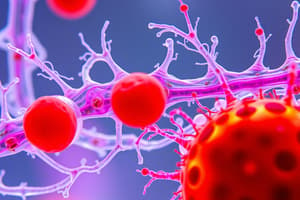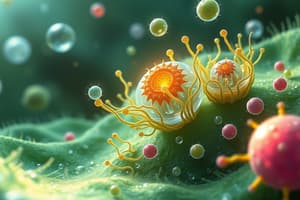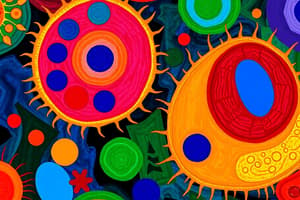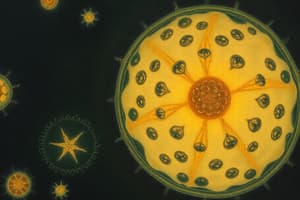Podcast
Questions and Answers
Which of the following statements is TRUE regarding eukaryotic cells?
Which of the following statements is TRUE regarding eukaryotic cells?
What is the function of the nucleolus within the nucleus?
What is the function of the nucleolus within the nucleus?
Which of these is NOT a component of the cytoplasm?
Which of these is NOT a component of the cytoplasm?
What is the primary function of the endoplasmic reticulum (ER) in cells?
What is the primary function of the endoplasmic reticulum (ER) in cells?
Which organelle is responsible for storing starch?
Which organelle is responsible for storing starch?
What is the primary function of the Golgi apparatus?
What is the primary function of the Golgi apparatus?
What is the primary difference between prokaryotic and eukaryotic cells?
What is the primary difference between prokaryotic and eukaryotic cells?
Which of the following is an example of a unicellular organism?
Which of the following is an example of a unicellular organism?
Which of the following organelles is NOT found in plant cells?
Which of the following organelles is NOT found in plant cells?
What is the role of the cytoskeleton in a cell?
What is the role of the cytoskeleton in a cell?
What is the function of the plasma membrane?
What is the function of the plasma membrane?
What is the main difference between cilia and flagella?
What is the main difference between cilia and flagella?
Which of the following organelles is responsible for protein synthesis?
Which of the following organelles is responsible for protein synthesis?
Which organelle contains its own DNA?
Which organelle contains its own DNA?
Which of the following is NOT a function of the cell wall?
Which of the following is NOT a function of the cell wall?
What is the primary function of peroxisomes?
What is the primary function of peroxisomes?
Flashcards
Rough ER
Rough ER
Smooth ER
Smooth ER
Golgi apparatus
Golgi apparatus
Lysosomes
Lysosomes
Mitochondria
Mitochondria
Vacuoles
Vacuoles
Chloroplasts
Chloroplasts
Cell wall
Cell wall
Cell
Cell
Eukaryotic Cells
Eukaryotic Cells
Prokaryotic Cells
Prokaryotic Cells
Multicellular Organisms
Multicellular Organisms
Nucleus
Nucleus
Cytoplasm
Cytoplasm
Organelles
Organelles
Ribosomes
Ribosomes
Study Notes
The Cell
- The cell is the fundamental unit of life.
- All living things are composed of one or more cells.
- Cells carry out essential functions like nourishment, environmental interaction, and reproduction.
Types of Cells
- Eukaryotic cells contain a nucleus.
- Prokaryotic cells lack a nucleus.
Organisms and Cell Number
- Unicellular organisms consist of a single cell.
- Examples include bacteria and protozoa.
- Multicellular organisms are formed from two or more cells.
- Examples include animals and plants.
Parts of the Cell
- Most cells share three basic components:
- Nucleus (excludes prokaryotic cells)
- Cytoplasm
- Plasma membrane
- Additional structures include:
- Cytoskeleton
- Organelles
- Cell wall (present in specific cell types)
Cytology
- Cytology is the biological study of cells and their functions.
- All living organisms rely on cells.
- Cells execute all life processes.
The Nucleus
- The nucleus is an internal structure exclusive to eukaryotic cells.
- It houses the genetic material of multicellular organisms.
- It's enveloped by cytoplasm and a membrane.
- It manages the activities of organelles within the cytoplasm.
- It directs cell reproduction.
- It holds the organism's genetic information.
Nucleus Structure
- Nuclear membrane: The outer layer of the nucleus.
- Nucleoplasm: The nucleus's internal fluid, containing various structures.
- Nucleolus: A dense region within the nucleus, responsible for ribosome production.
- Chromatin: Structures of proteins and DNA (deoxyribonucleic acid).
- Chromatin packages into chromosomes.
Cytoplasm
- Cytoplasm is the watery, gel-like substance within the cell.
- Cytoskeleton: A dynamic filament network in all cell types.
- The cytoskeleton gives the cytoplasm and membrane their shape, consistency, and dynamism.
- It's continuously changing.
- Organelles: Small, specialized structures within the cytoplasm performing varied functions.
- Their number and type change based on the cell's function.
Organelles
- Ribosomes: Present in all cells.
- Composed of two RNA subunits.
- Synthesize enzymes and proteins.
- Endoplasmic reticulum (ER): A membrane network transporting proteins.
- Rough ER: Receives proteins.
- Smooth ER: Creates new membranes.
- Golgi apparatus: Sacs near the nucleus, processing and packaging molecules from the ER into vesicles for cell export.
- Lysosomes: Membranous sacs digesting cellular material.
- Mitochondria: Two-membraned sacs generating energy for the cell through chemical reactions.
- Each mitochondrion contains its own DNA (mitochondrial chromosome).
Organelles Found Only in Plant Cells
- Vacuoles: Compartments in eukaryotic plant cells storing fluids (like water) and potentially enzymes and nutrients.
- Plastids: Involved in photosynthesis, starch storage or synthesis of various materials.
- Chloroplasts: Carry out photosynthesis.
- Amyloplasts: Store starch.
- Leucoplasts: Synthesize materials.
Peroxisomes
- Vesicle-shaped organelles for hydrogen peroxide oxidation and disposal.
Centrioles
- Barrel-shaped organelles aligned at right angles, crucial for cell division.
Flagella
- A single, elongated cellular projection for cell movement.
Cilia
- Multiple, thin cellular projections facilitating cell and fluid movement.
Plasma Membrane
- Plasma membrane (cell membrane/plasmalemma): The cell's outer boundary.
- Functions include:
- Maintaining cell stability.
- Controlling molecule entry/exit.
- Facilitating cell-cell communication.
- Functions include:
Cell Wall
- Cell wall: Present in prokaryotes, plant cells, and fungi.
- A rigid outer layer covering the plasma membrane.
- Functions include:
- Protecting the plasma membrane from osmotic stress.
- Maintaining cell shape.
- Preventing dehydration.
Studying That Suits You
Use AI to generate personalized quizzes and flashcards to suit your learning preferences.




